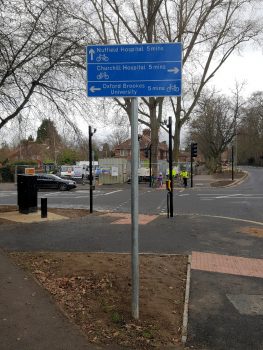
Last week I had a moan about the new cycle route signposts installed at the Gipsy/Warneford/Roosevelt/Old road junction, complaining that they were set too high for cyclists to see them. This sparked quite a debate on twitter, with some people saying it was ‘the regulations’ and me asking for chapter and verse.
I can’t believe I’ve been spending time on this, but here’s what I’ve found out.
The definitive source of everything statutory about road signs is the Traffic Signs Regulations and General Directions 2016. Astonishingly for such a vast and comprehensive document, it is silent (as far as I can find) on the matter of height above ground.
We then turn to the Traffic Signs Manual. This Government publication says
The Traffic Signs Manual is intended to give advice to traffic authorities and their agents on the correct use of signs and road markings. Mandatory requirements are set out in the current version of the Traffic Signs Regulations and General Directions; nothing in the Manual can override these.
The Manual comes in several chapters. Chapter 2 (Informatory Signs) would appear to be the relevant one, but it is still in draft. However the Manual web page for this chapter says
The current advice on the design and use of directional informatory signs is published in Local Transport Note (LTN) 1/94.
So (noting it’s 23 years old) I went to LTN 1/94, only to find that it too is silent on the question of mounting height.
But back in the Traffic Signs Manual I found that both Chapter 3 (Regulatory Signs) and Chapter 4 (Warning Signs) do have something to say. In Ch.3 1.21 and Ch 4 1.24 I at last found this:
MOUNTING
The normal mounting height measured to the lower edge of a sign or backing board (or any supplementary plate) is between 900 mm and 1500 mm above the carriageway alongside. The greater height should be used where vehicle spray is likely to soil the sign, or above planted areas. Careful consideration should be given to any proposal to mount signs at a low height, such as on railings or bollards, as there is a risk of drivers not noticing them, especially at night or when they could be obscured by parked vehicles or pedestrians. Where signs are erected above footways, or in areas likely or intended to be used by pedestrians (e.g. pedestrian refuges), a headroom of 2300 mm is recommended, with 2100 mm as an absolute minimum. A clearance of at least 2300 mm should be maintained over a cycle track or shared cycleway / footway.
This must be where Sustrans get their recommendations from. In their handbook “Cycle Network Signing” (July 2013) they say
4.2 Carriageway and cycle path signs should normally be set back to give a clearance of at least 500mm from the edge of the carriageway or cycle path. Where signs are located closer to or on a cycle route, they reduce the effective path width available for cyclists.
The best level to fix a sign in the verge for visibility by cyclists is between 900 and 1500 mm off the ground, although care must be taken not to obstruct the visibility of children on footways adjacent to highways with low level signs. Mounting a sign at this level however reduces its visual intrusion. However, where signs might overhang cycle or walking routes, the mounting height should allow a minimum of 2.1m clearance for pedestrians and 2.3m for a cycle track. The minimum clearance for equestrians is 3.4m. Mounting heights should also have regard to possible vandalism and theft – higher posts are recommended where such problems are expected. p.31, with thanks to @SafetyG1rl for the reference.
To see if there is any research to justify the 2.1/2.3 metre policy and its implications of head-banging cyclists and pedestrians I searched the publications of TRL, the now-private company that used to be the Transport and Road Research Laboratory (TRRL). I found nothing. It just seems to have worked its way into the system, probably by a route invoking Health & Safety.
Where does this leave us? The 2.1/2.3 metre standard for signs over a footway or cycleway seems to be advisory rather than statutory, but I imagine it would be a brave highways engineer who did something different. But there is no reason why cycle route signs which don’t overhang walking or cycling paths shouldn’t be lower; Sustrans’ 0.9 – 1.5 metres above ground for example. It means wherever a new sign is needed an effort should be made to find a location which would allow the lower height option. Cycling signs higher than two metres should only be used when there’s no alternative.
So here is my message to the highway engineers working on the next phases of Access to Headington: take the time to look around, be imaginative, and see if you can’t find a way to do this.
Acknowledgements. My thanks to these people on twitter who joined in the conversation with suggestions and comments: @DarrenGrant_UK, @KarlWallendszus, @RichardF, @RuthWilk, @SafetyG1rl.